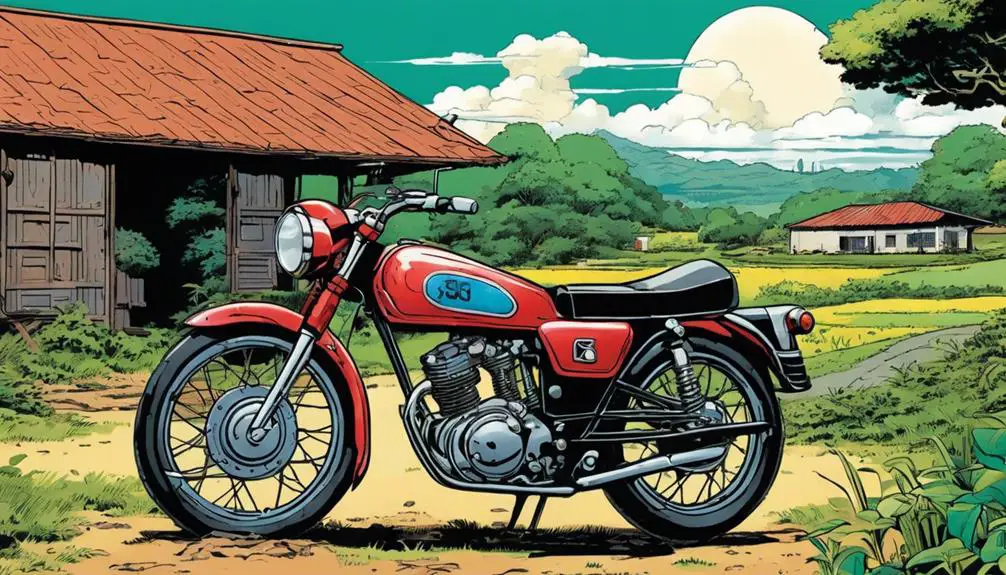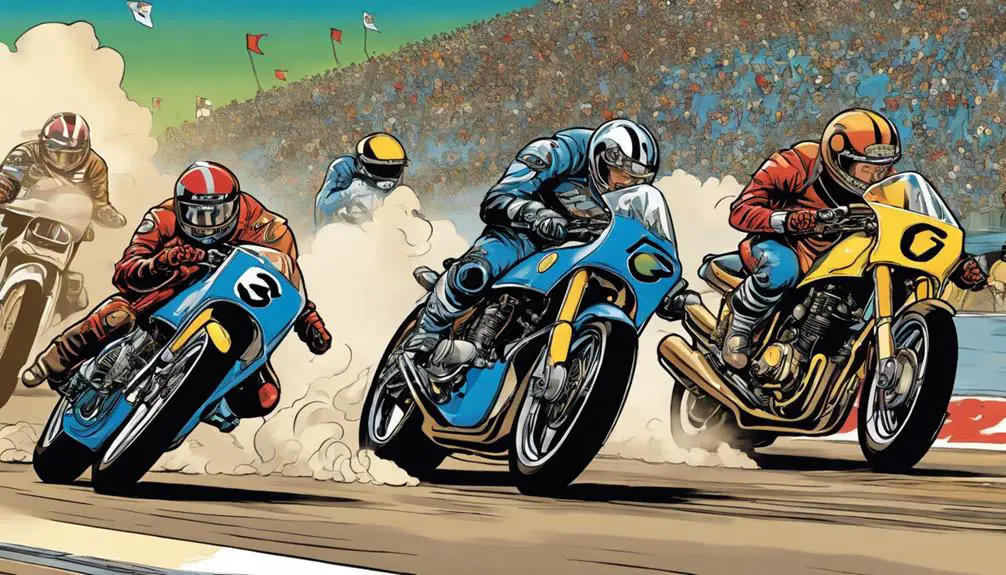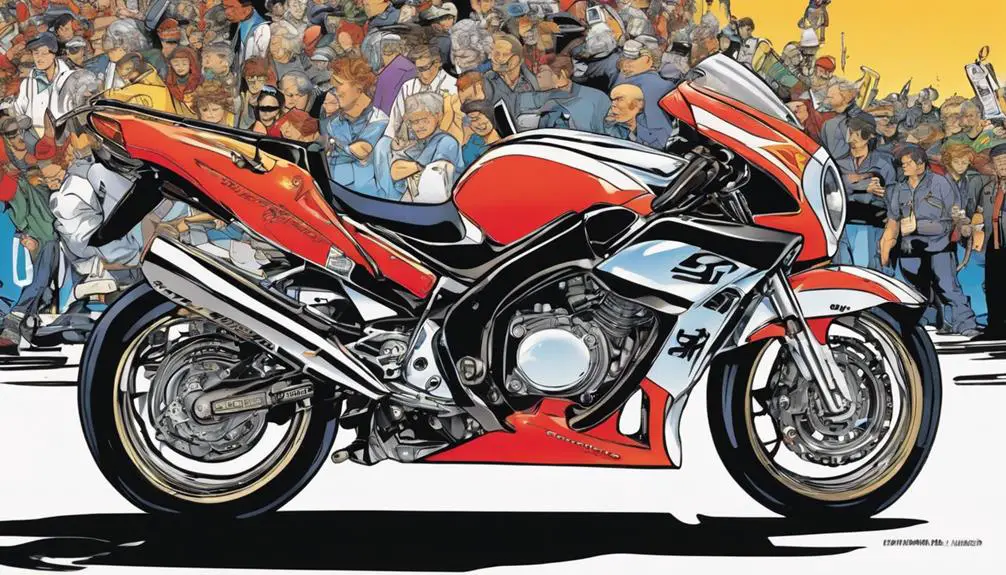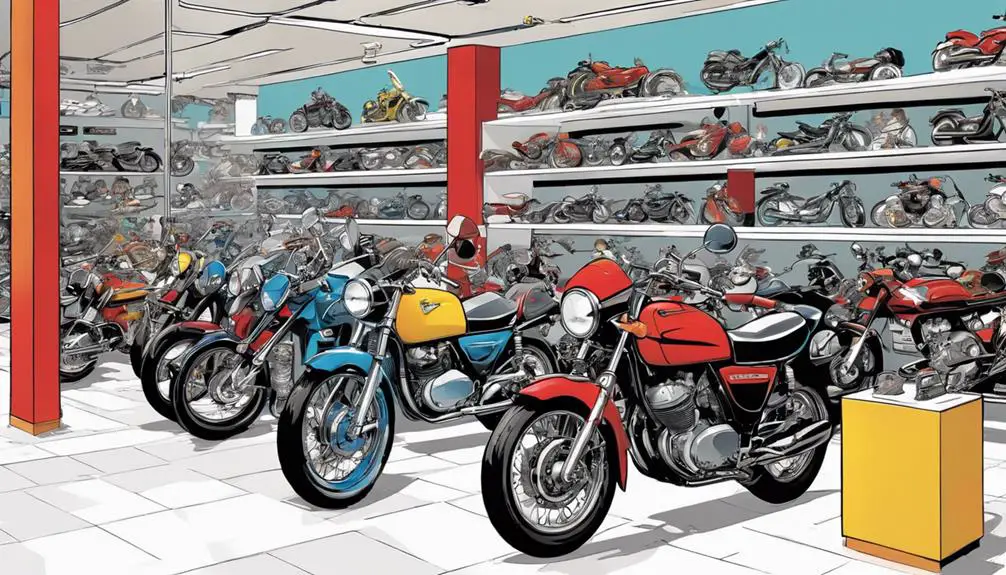When you explore the history of Suzuki motorcycles, you uncover a narrative rich in innovation and resilience that's shaped the entire motorcycle industry. From its origins in the 1950s to its rise as a global leader, Suzuki's story reflects not just technological advancements but also cultural shifts within the riding community. Each model tells a story, and each innovation marks a pivotal moment. What might you discover about how these elements interconnect and influence today's riding experience? The journey is more complex than you might think.
Quick Takeaways
- Understanding Suzuki's transition from loom machines to motorcycles highlights its innovative beginnings and impact on affordable transportation.
- Iconic models like the T20 Super Six and Hayabusa showcase Suzuki's commitment to performance and rider experience throughout the decades.
- Technological advancements, including DOHC engines and fuel injection, demonstrate Suzuki's role in shaping modern motorcycle engineering and efficiency.
- The brand's ability to adapt during market challenges illustrates resilience and ongoing dedication to rider needs and preferences.
Early Beginnings in the 1950s

In the 1950s, Suzuki shifted from making loom machines to producing its first motorcycles, laying the groundwork for a future in the motorbike industry. You can appreciate how this change marked a bold step toward freedom and self-expression. With the release of the Suzuki Colleda, the company began to cater to a growing demand for affordable, efficient transportation. Imagine the thrill of riding through the streets, wind in your hair, feeling the exhilaration of newfound mobility.
This era wasn't just about machines; it was about liberation. Suzuki understood that motorcycles could represent a lifestyle—an escape from the confines of everyday life. They designed bikes that weren't just functional but also accessible, inviting everyone to embrace the open road. You could sense the spirit of adventure in every model, as Suzuki encouraged riders to break free from traditional norms and explore new horizons.
As you explore these early beginnings, you'll see how Suzuki planted the seeds for a revolution in motorcycle culture. Each bike symbolized the promise of independence, urging you to chase your dreams and live life on your own terms.
Expansion Into Motorcycle Production
As Suzuki embraced the growing motorcycle market, it rapidly expanded its production capabilities to meet the increasing demand for reliable and affordable bikes. This shift not only fueled the company's growth but also provided riders like you with the freedom to explore the open road.
Here are three key factors that drove Suzuki's expansion into motorcycle production:
- Innovative Design: Suzuki focused on crafting motorcycles that combined performance with affordability, making them accessible to a broader audience.
- Strategic Partnerships: Collaborating with various suppliers and distributors enabled Suzuki to streamline its manufacturing processes, ensuring quicker production times.
- Global Reach: By exporting motorcycles worldwide, Suzuki established itself as a global player in the motorcycle industry, giving riders everywhere the chance to experience their bikes.
With these strategies in place, Suzuki not only transformed its production landscape but also empowered countless individuals to embrace a lifestyle centered around adventure and autonomy.
The expansion into motorcycle production marked a pivotal moment in the company's history, one that continues to resonate with riders seeking liberation on two wheels.
Iconic Models of the 1960s
The 1960s saw Suzuki launch several iconic motorcycle models that defined an era of innovation and style, capturing the hearts of riders everywhere. You can't talk about this decade without mentioning the Suzuki T20 Super Six, a bike that combined sleek design with impressive performance. This 1966 model showcased Suzuki's engineering prowess, featuring a 250cc two-stroke engine that delivered exhilarating speed and agility.
Another standout was the Suzuki 125, a model that opened the doors for many new riders. Its lightweight frame and user-friendly mechanics made it an ideal choice for those seeking freedom on two wheels. You could easily feel the thrill of the open road, embracing the liberation that motorcycling offers.
The 1969 Suzuki Titan 500 further pushed boundaries with its powerful performance and distinctive styling, attracting enthusiasts who craved adventure. Each of these models didn't just represent a motorcycle; they symbolized a lifestyle, one that encouraged exploration and self-expression.
As you look back on these unforgettable machines, think of how they paved the way for generations of riders, igniting a passion that still burns brightly today.
Innovations in the 1970s
Suzuki revolutionized the motorcycle industry in the 1970s with groundbreaking advancements in technology and design that set new standards for performance and safety. You felt the thrill of riding as they introduced innovations that changed the game.
Here are three key developments that defined the decade:
- The Introduction of the Two-Stroke Engine: Suzuki's mastery of the two-stroke engine delivered incredible power-to-weight ratios, allowing riders to experience unmatched speed and agility.
- The Launch of the GT Series: With the GT750, Suzuki pushed boundaries, integrating a water-cooled engine that enhanced reliability and performance, fostering a new sense of freedom on the open road.
- Advancements in Suspension Technology: They introduced the full-coverage fairing and improved suspension systems, offering enhanced stability and comfort, empowering you to conquer any terrain with confidence.
These innovations didn't just enhance performance; they redefined the way you experienced riding.
The 1970s were a time of liberation for motorcyclists, where you could embrace the open road with the assurance that Suzuki had your back, setting you free to chase your dreams on two wheels.
The Impact of Racing

Racing has played a pivotal role in shaping Suzuki's motorcycle legacy, pushing the boundaries of technology and performance to new heights. When you think about Suzuki, you can't ignore the adrenaline-fueled spirit that racing embodies. Each victory on the track has inspired engineers to innovate, leading to groundbreaking advancements in engine design, suspension, and aerodynamics.
As a rider, you benefit from this relentless pursuit of excellence. The lessons learned in high-stakes racing environments trickle down into everyday models. You'll find yourself enjoying enhanced stability, sharper handling, and more powerful engines—all thanks to Suzuki's commitment to racing.
Beyond the machines, racing fosters a culture of freedom and community among riders. It's not just about competition; it's about connecting with like-minded individuals who share a passion for speed and exploration.
Challenges in the 1980s
During the 1980s, Suzuki faced significant challenges that tested its resilience and adaptability in an increasingly competitive motorcycle market. You might be surprised to learn that the company had to navigate through a mix of economic shifts, changing consumer preferences, and fierce competition.
Here are three key challenges Suzuki confronted:
- Economic Recession: The global economy slowed down, impacting motorcycle sales. You'd have to respond quickly to maintain profitability.
- Increased Competition: Rival brands were also ramping up their game, making it harder to capture market share. Staying ahead required innovative strategies and bold moves.
- Shifting Consumer Trends: Riders were looking for more than just speed; they wanted comfort, style, and reliability. Suzuki had to pivot to meet these evolving desires.
Through these challenges, Suzuki learned to innovate and adapt, which laid the groundwork for its future successes. You can appreciate how these struggles helped shape the brand into a symbol of freedom and adventure, driving the spirit of liberation among riders worldwide.
Embracing these hurdles ultimately strengthened Suzuki's identity in the motorcycle community.
Technological Advancements in the 1990s

In the 1990s, Suzuki made significant strides in motorcycle technology that changed the game for riders.
You'll notice innovations in engine efficiency, lightweight frame design, and advanced suspension systems that enhanced performance and comfort.
Let's explore how these advancements shaped the riding experience during this pivotal decade.
Engine Innovations and Efficiency
The 1990s marked a pivotal era for Suzuki motorcycles, as the company introduced groundbreaking engine technologies that greatly improved performance and fuel efficiency. These innovations not only set Suzuki apart but also redefined what riders could expect from their machines. You'd find yourself reveling in the thrill of superior engineering that offered liberation on the open road.
Here are three key advancements that made a difference:
- Dual Overhead Cam (DOHC) Engines: These engines allowed for higher RPMs and better airflow, giving you more power without sacrificing efficiency.
- Fuel Injection Systems: Shifting from carburetors to fuel injection meant precise fuel delivery, resulting in smoother acceleration and reduced emissions.
- Liquid Cooling: This technology helped maintain ideal engine temperatures, enhancing reliability and performance, especially during long rides.
With these innovations, Suzuki empowered you to embrace the freedom of the ride, offering machines that delivered both power and economy. As you experienced the open road, you could feel the thrill of technological progress fueling your passion for adventure.
Lightweight Frame Design
How did Suzuki revolutionize motorcycle design in the 1990s? By focusing on lightweight frame technology, the company enhanced maneuverability and performance, making rides more exhilarating.
You'll find that these innovations allowed you to experience a new level of freedom on the open road. With lighter materials like aluminum and advanced composites, Suzuki crafted frames that not only reduced weight but also improved rigidity.
This shift meant you could enjoy sharper handling and quicker responses, revealing a sense of liberation as you navigated curves and straightaways. The nimbleness of these motorcycles made them ideal for both urban commuting and spirited weekend rides, allowing you to break free from the everyday grind.
Suzuki's commitment to lightweight design didn't just improve speed; it also heightened safety and comfort. You could ride longer with less fatigue, embracing the thrill of the journey without feeling weighed down.
As you look back, it's clear that this pursuit of innovation paved the way for more accessible and enjoyable riding experiences. Suzuki didn't just create motorcycles; they crafted tools for your adventure, enabling you to feel the wind and release your spirit on every ride.
Advanced Suspension Systems
Suzuki stepped up its game in the 1990s by integrating advanced suspension systems that dramatically improved ride quality and handling. These innovations gave you a sense of freedom and control, allowing you to conquer diverse terrains with confidence.
Here's what made these systems stand out:
- Fully Adjustable Suspension: You could fine-tune your ride to match your preferences, whether you were cruising on highways or tearing through backroads.
- Progressive Linkage: This design guaranteed a smoother changeover between compression and rebound, providing a more stable ride that felt almost effortless.
- Anti-Dive Technology: With this feature, you could brake harder without worrying about the front end diving too much, enhancing your safety and overall riding experience.
These advancements weren't just about technology; they were about liberating you as a rider. By focusing on comfort, control, and performance, Suzuki transformed how you experienced the open road.
You weren't just riding a motorcycle; you were embracing freedom, adventure, and the thrill of the journey. The 1990s marked a pivotal moment in Suzuki's commitment to enhancing your riding experience, and it's a legacy that continues today.
Resurgence in the 2000s
In the 2000s, a renewed focus on innovation and performance helped catapult Suzuki motorcycles back into the spotlight. You'll notice that this era marked a significant turning point, as Suzuki embraced cutting-edge technology to enhance the riding experience. The introduction of models like the GSX-R series showcased exceptional speed and agility, appealing to riders enthusiastic for freedom on the open road.
With advances in engine design, aerodynamics, and lightweight materials, Suzuki motorcycles became synonymous with liberation and thrill. The brand didn't just aim for performance; it also prioritized rider comfort and handling, creating machines that felt intuitive and responsive. You could feel the passion in every twist of the throttle, igniting your adventurous spirit.
Moreover, Suzuki's commitment to racing played a vital role in this resurgence. You'd see their bikes dominating tracks worldwide, proving their prowess and attracting enthusiasts who craved the same adrenaline rush. The blend of innovation, racing heritage, and a focus on the rider experience transformed Suzuki into a key player in the motorcycle market, allowing you to reclaim that exhilarating sense of freedom on two wheels.
Current Models and Legacy

As you explore Suzuki's current models, you'll notice a blend of iconic designs and cutting-edge technology.
These bikes not only pay homage to their storied past but also push the boundaries of performance and innovation.
Understanding this legacy is key to appreciating how Suzuki continues to shape the motorcycle industry today.
Iconic Models Overview
Iconic models from Suzuki's lineup showcase a rich legacy while continuing to influence the motorcycle industry today. These machines embody freedom, power, and the spirit of adventure. If you're craving a ride that resonates with history and performance, check out these standout models:
- Suzuki GSX-R Series: Known as the original sportbike, this series revolutionized motorcycle racing and street performance. It's built for those who live for speed and agility.
- Suzuki V-Strom: This adventure touring bike invites you to explore the open road, blending comfort with versatility. It's designed for riders who see the world as their playground.
- Suzuki Hayabusa: Often dubbed the fastest production motorcycle, the Hayabusa embodies raw power and engineering excellence. It's crafted for those who seek the thrill of the ride without limits.
These models not only represent Suzuki's innovative spirit but also inspire a sense of liberation for riders.
Whether you're hitting the racetrack or the winding backroads, these iconic motorcycles invite you to embrace the adventure that lies ahead.
Technological Innovations Impact
Revolutionizing the riding experience, Suzuki has consistently integrated cutting-edge technology into its current models, enhancing performance and safety while honoring its rich legacy. Whether you're tearing down the highway or carving through twisty backroads, Suzuki's innovations empower you to release your spirit of adventure.
Take the GSX-R series, for example. Equipped with advanced electronics, these bikes offer traction control, ride modes, and ABS, ensuring you can push the limits confidently. The V-Strom line, celebrated for its versatility, features sophisticated suspension systems and lightweight chassis, making every ride a smooth escape.
Suzuki's commitment to environmental responsibility is another key aspect of its legacy. The adoption of fuel-efficient engines and eco-friendly designs means you can enjoy the thrill of the ride while minimizing your carbon footprint.
Every new model reflects Suzuki's dedication to creating a harmonious blend of performance, safety, and sustainability. So, when you choose a Suzuki motorcycle, you're not just riding a machine; you're embracing a legacy that continuously evolves to meet the desires of freedom-loving riders like you.
Experience the innovation, and feel the liberation that comes with every twist of the throttle.
Lessons From Suzuki's Journey
Suzuki's journey offers valuable insights into resilience and innovation in the ever-evolving motorcycle industry. As you explore their history, you'll discover that success isn't just about making great bikes; it's about adapting to challenges and seizing opportunities.
Here are three key lessons to inspire your own path:
- Embrace Change: Suzuki faced numerous market shifts and technological advancements. By embracing change rather than resisting it, they consistently evolved their products to meet consumer needs.
- Cultivate Innovation: The company's focus on research and development has led to groundbreaking designs. Staying curious and fostering creativity can help you push boundaries in your own pursuits.
- Build a Strong Community: Suzuki's commitment to customer engagement built a loyal fan base. By connecting with others who share your passions, you can create a supportive network that fuels your journey.
In a world full of uncertainty, Suzuki's story reminds you that resilience and innovation are keys to liberation. As you navigate your own path, remember to adapt, innovate, and connect with your community. These lessons can empower you to forge your own unique journey.
Common Questions
How Did Suzuki Motorcycles Influence Popular Culture and Media?
'Where there's a will, there's a way.'
Suzuki motorcycles didn't just hit the roads; they became symbols of freedom and adventure. Their sleek design and reliability captured the imagination of riders everywhere, inspiring a wave of films, music, and fashion.
You can see their influence in countless media, celebrating the thrill of the open road. By embracing Suzuki's spirit, you're part of a movement that celebrates liberation and the joy of riding.
What Are the Environmental Impacts of Suzuki Motorcycle Production?
When you consider the environmental impacts of Suzuki motorcycle production, you'll see both positives and negatives.
On one hand, manufacturing processes can generate pollution and waste.
On the other hand, Suzuki has made strides in developing more fuel-efficient models and reducing emissions.
By actively engaging in sustainable practices, they're working to lessen their footprint.
Your awareness and choices around these motorcycles can further drive demand for greener alternatives in the industry.
How Does Suzuki Compare to Other Motorcycle Manufacturers Historically?
Imagine riding through a winding forest, where each motorcycle represents a unique path.
Suzuki stands out with its nimble agility and innovative spirit, often outpacing competitors.
While brands like Honda and Yamaha echo with power, Suzuki's history weaves tales of adaptability and resilience.
You'll find it crafted machines that embrace liberation, offering riders a sense of freedom.
In the grand race of manufacturers, Suzuki's journey is a tribute to the art of reinvention.
What Role Do Suzuki Motorcycles Play in Today's Motorcycling Community?
Suzuki motorcycles play an essential role in today's motorcycling community, offering a blend of performance, reliability, and innovation.
You'll find a diverse range of models catering to every rider's needs, from thrill-seekers to casual commuters.
Their strong presence in competitions showcases their engineering prowess, while the brand's commitment to sustainability resonates with eco-conscious riders.
How Has Globalization Affected Suzuki's Operations and Motorcycle Design?
Globalization has been like a powerful wind, shaping Suzuki's operations and motorcycle design.
You'll notice how they've embraced diverse influences, blending styles and technologies from around the world. This fusion fuels creativity, allowing you to ride machines that reflect a global spirit.
Their supply chains have expanded, making parts accessible and production efficient.
Ultimately, you see Suzuki evolving into a brand that embodies freedom, connecting riders across cultures and continents.
Wrapping Up
Studying Suzuki's motorcycle history isn't just about machines; it's about the passion and community that fueled their evolution.
From humble beginnings to iconic designs, each chapter reflects resilience and innovation.
As you explore their journey, you might ask yourself: what drives your own passion for riding?
Understanding Suzuki's legacy can inspire you to embrace creativity and adaptability in your own adventures, reminding you that the spirit of motorcycling is alive in every twist and turn of the road.